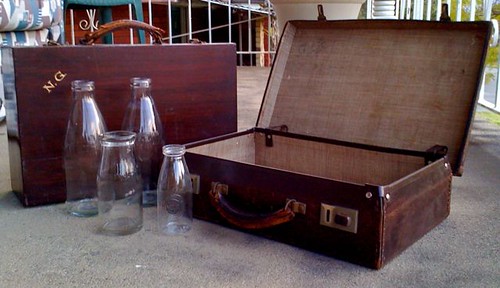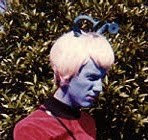Since then, I've been on the lookout for a third-of-a-pint "school milk" glass bottle, without a lot of success. What used to be such a ubiquitous object in primary schools of the 1950s and 60s and essentially vanished off the face of the earth. Recently, I was given a few regular one-pint (600 ml) milk bottles and even a half-pint cream bottle, but numerous visits to antique stores proved fruitless. In 2007, the Royal Easter Show featured a special offer: plastic replicas of the "school milk" bottles (but marked 200 ml) - and I was beginning to think that was going to be as close as we could ever get. One of the teachers has a waxed paper drinking straw of the same bygone era as the milk bottles, which she has promised to donate if we can find a bottle, but yesterday we were doing the happy dance of an archeologist!

Two glass 600 ml milk bottles (1970s) and an Imperial half pint cream bottle (1960s).
For scale, they stand next to my plastic replica of a 1960s
Dairy Farmers' school milk 1/3 pint bottle.
The workmen excavating the ground for our new library's foundations found, on the site of the old library, two examples of actual 1/3 pint "school milk" bottles buried in the rubble. They are both embossed, in slightly different ways, with "1/3 PINT PASTEURISED MILK" in raised lettering.
The "Moment in time" episode (#37) of the ABC-TV series, "Can we help?", and the online transcript, explains that the "School Milk Scheme" was originally the idea of the British Medical Association, which had promoted that children under thirteen years of age needed a daily ration of milk. It "would be beneficial for school children’s physical and mental development", and by 1951 the Menzies' government had all Australian primary school students being offered milk daily. It was supposedly promoting "bone growth and well being and general good health", but more cynical types considered it was a program to remove a glut of milk from local sources. The scheme ended in 1973 under the direction of the Whitlam government, no doubt reacting to Nugget Coombes' full report into government spending. Supposedly, "one of the things he discovered when he looked at the school milk scheme was that it wasn’t doing any good at all. It had a marginal or very slight effect on the health of children" and the scheme was scrapped - just as many schools took delivery of fridges, if I recall, that would have kept the milk icy cold (for a change!)
Ask any adult who was at school in the 50s and 60s and they'll all have some wild and wacky anecdotes about school milk. Amongst my own is the solving of the mystery of the little black specks that began appearing in our classroom's milk supply one term. New milk monitors had been appointed, and it was their job to remove all the silver foil caps from the bottles and insert the waxed paper straws, thus encouraging even the laziest student to partake of his average daily allowance of dairy! After several frustrating days of putting up with the enigmatic black speckles, we finally caught Jeffrey, the shorter of the two monitors, standing atop the crate of opened bottles in his plastic-sandalled feet, spruiking his wares to all and sundry. Yes, it was little chunks of fine asphalt gravel, trapped in the crevices of his footwear, which had been polluting our milk.

Our amazing archeological find!










No comments:
Post a Comment